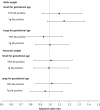Birth weight and placental weight in children born to mothers with hypothyroidism
- PMID: 40570047
- PMCID: PMC12257604
- DOI: 10.1530/ETJ-25-0111
Birth weight and placental weight in children born to mothers with hypothyroidism
Abstract
Objective: Hypothyroidism in pregnant women has been linked to deviations in birth weight, but associations are not consistent and the role of confounding factors, including maternal body mass index (BMI), is not clear. This study aimed to evaluate the association between maternal hypothyroidism, birth weight of the child, and placental weight.
Methods: This was a retrospective register-based study of singleton live births in Denmark from 2004 to 2015 (n = 694,734). Small for gestational age (SGA) (<10th percentile), large for gestational age (LGA) (>90th percentile), and placental weight Z-scores were defined according to gestational week at birth and sex of the child. Associations were evaluated using logistic and linear regression, adjusting for potential confounders, which included maternal BMI.
Results: Altogether, 9.8 and 9.9% of pregnant women with no diagnosis of hypothyroidism gave birth to SGA and LGA children. The frequency of SGA was higher among children whose mothers were newly diagnosed with hypothyroidism in pregnancy (12.4%; adjusted odds ratio (aOR) = 1.16 (95% confidence interval (CI): 1.00-1.34)), but not LGA (9.3%; aOR = 1.03 (95% CI: 0.87-1.21)). Children born to mothers with treated hypothyroidism in pregnancy did not have higher frequencies of SGA (aOR = 0.94 (95% CI: 0.86-1.03)) or LGA (aOR = 1.06 (95% CI: 0.98-1.14)). No association between maternal hypothyroidism and placental weight Z-score was found (adjusted beta coefficient: 0.004 (95% CI: -0.016; 0.024)).
Conclusions: The findings from a large Danish cohort point toward an association between hypothyroidism in pregnancy and lower birth weight of the child, whereas no association with placental weight was found.
Keywords: birthweight; gestation; placental; pregnancy; thyroid.
Conflict of interest statement
The authors declare that they have no conflicts of interest that could be perceived as prejudicing the impartiality of the research reported.
Figures


Similar articles
-
Metformin for women who are overweight or obese during pregnancy for improving maternal and infant outcomes.Cochrane Database Syst Rev. 2018 Jul 24;7(7):CD010564. doi: 10.1002/14651858.CD010564.pub2. Cochrane Database Syst Rev. 2018. PMID: 30039871 Free PMC article.
-
Screening and subsequent management for thyroid dysfunction pre-pregnancy and during pregnancy for improving maternal and infant health.Cochrane Database Syst Rev. 2015 Sep 21;2015(9):CD011263. doi: 10.1002/14651858.CD011263.pub2. Cochrane Database Syst Rev. 2015. PMID: 26387772 Free PMC article.
-
Multiple-micronutrient supplementation for women during pregnancy.Cochrane Database Syst Rev. 2017 Apr 13;4(4):CD004905. doi: 10.1002/14651858.CD004905.pub5. Cochrane Database Syst Rev. 2017. Update in: Cochrane Database Syst Rev. 2019 Mar 14;3:CD004905. doi: 10.1002/14651858.CD004905.pub6. PMID: 28407219 Free PMC article. Updated.
-
Use of biochemical tests of placental function for improving pregnancy outcome.Cochrane Database Syst Rev. 2015 Nov 25;2015(11):CD011202. doi: 10.1002/14651858.CD011202.pub2. Cochrane Database Syst Rev. 2015. PMID: 26602956 Free PMC article.
-
Prenatal Diet and Infant Growth From Birth to Age 24 Months.JAMA Netw Open. 2024 Nov 4;7(11):e2445771. doi: 10.1001/jamanetworkopen.2024.45771. JAMA Netw Open. 2024. PMID: 39570591 Free PMC article.
References
MeSH terms
LinkOut - more resources
Full Text Sources
Medical

